CSI Undergrad Research Conference
2015
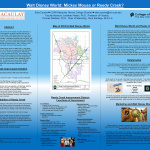 Elisa Csorba, Walt Disney World: Mickey Mouse or Reedy Creek?
Elisa Csorba, Walt Disney World: Mickey Mouse or Reedy Creek?
Walt Disney World is typically known as the ultimate vacation destination, a place where families can come together to create memories and have an experience they will always remember. Walt Disney World is an enormous piece of property, 25,000 acres, covering four theme parks, two water parks, over 20 resorts, four golf courses, a downtown shopping area, and more, with continuous expansion every year. In order to continuously stay with the times and improve this massive piece of land, the Florida State Legislature created a municipal entity for the Walt Disney World Resort in 1967, in order to more easily and effectively put into place its land and transportation needs. The municipal alter ego of Walt Disney World is called RCID, or the Reedy Creek Improvement District. All of the land use needs within the Walt Disney World Resort are controlled by one of the two organizations: Walt Disney World Parks and Resorts or the municipal RCID entity. Unlike other theme parks and resorts, this municipal entity provides the Disney Corporation with various opportunities and controls not normally found in the private sector. This paper seeks to explore the various aspects of this interesting hybrid of government and corporation. In particular, we focus on the operational governance and cost sharing aspects of this municipal entity. Further discussion of the ramifications and opportunities presented by these agreements will be explored.
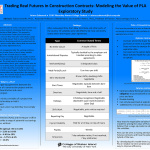 Ariana Zuberovic, Trading Real Futures in Construction Contracts: Modeling the Value of PLA Exploratory Study
Ariana Zuberovic, Trading Real Futures in Construction Contracts: Modeling the Value of PLA Exploratory Study
This study seeks to explore the area of contract valuation and the issue of no strike clauses in construction contracts. We believe that this area represents an extension of the idea of Real Options. This research is motivated by the Building and Construction Trade Council of NY (the organization of construction unions in New York) who were told by a judge in a labor dispute case that “no-strike clauses” had no value. CCNY and the College of Staten Island worked on developing methods to understand the value that is created by a no-strike or other labor clauses that are controlled through what is called a Project Labor Agreement (PLA). Using a PLA, the labor and management alter the working conditions and trade various components of value (hours of work, salary, benefits, strike clauses etc) in exchange for the no-strike clause. We have developed a working special case model; however this study hopes to develop a more general model to understand the drivers of value and the value created. This study hopes to develop a wage equivalent value for these commodities, that is, give a quantitative value for hours of work in exchange of a no strike clause, for example. Previous court cases have suggested that a no strike clause has essentially no value in an agreement since to monetary funds are exchanged. The desire to have these clauses however and the immense safety-net they provide in the area of risk management suggests otherwise. This research hopes to see a correlation between valuing real options and these no strike clauses.
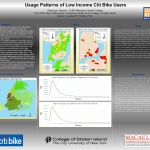 Shenuque Tissera, Exploring Low Income User Behavior in the New York Citi Bike Program
Shenuque Tissera, Exploring Low Income User Behavior in the New York Citi Bike Program
Citi Bike is the largest bike share system in the United States, outperforming other programs such as Boston’s Hubway and Washington’s Capital bikeshare programs. To fully explore the value of this transportation method and to develop better operational practices, we argue that a full understanding of usage patterns of riders is necessary. In our preliminary analysis, it is clear that bike share users vary considerably and there is not just one type of rider. In fact, Citi Bike seems to be skewed towards the more affluent even though lower income riders can receive subsidized memberships.
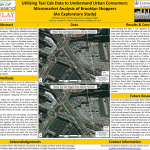 Michelle Kushnir, Utilizing Taxi Cab Data to Understand Urban Consumers: Micromarket Analysis of Brooklyn Shoppers
Michelle Kushnir, Utilizing Taxi Cab Data to Understand Urban Consumers: Micromarket Analysis of Brooklyn Shoppers
This project seeks to study urban consumers and understand how they get to and from shopping destinations. Utilizing the detailed information from the Global Positioning System (GPS) tracking of yellow medallion taxi cabs in New York City, the author seeks to explore the patterns of shopping activities in the borough of Brooklyn. The GPS tracking of New York City taxicabs has allowed us to examine detailed patterns of mobility in New York City.
This data, made available to the author through the CUNY High Performance Computing Center and in partnership with Columbia University, has over 173 million records each year. In addition, this data is accurate down to the 10 centimeter level (4 inches) and as such we can explore detailed trip level activity that actually originates or destinates around the
New York Metro region. In particular, I look to explore individual destination shopping areas in Brooklyn and analyze the projected demographic and income profile of these users based upon U.S. Census data. Brooklyn offers a rich portfolio of shopping destinations and a variety of housing option that I look to explore in terms of shopping behavior. Geospatial analysis will be completed in this project as well as examination of spatial field conditions at various shopping venues.
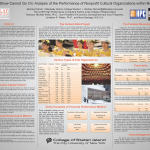 Zachary Diemer, Analysis of the Performance of Nonprofit Cultural Organizations within New York City
Zachary Diemer, Analysis of the Performance of Nonprofit Cultural Organizations within New York City
Within the year of 2002, a man by the name of Richard Florida stunned the economic community by proposing a new economic theory titled the Creative Capital Theory. In this theory, Florida proposed an alteration to Human Capital Theory: What if in today’s modern society creative people were in fact the “motor force behind regional [and economic] growth” rather than abundant amenities of geography. In his paper “Cities and the Creative Class” he explains who is in the creative class, why the creative class is important, and how both of these ideas play a particularly important role in the future development of cities (or creative centers). But so what? Some of the main constitutes (or members) within the creative class are artists, entertainers, poets, novelists, nonfiction writers, editors, cultural figures, architects, actors, and designers. High populations of these individuals, according to Florida, along with certain atmospheric characteristics (such as the 3T’s Technology, Tolerance, and Talent), have been statistically correlated with regional employment growth, high-technological growth, and population growth. But Why is this important? This is important because it gives insight to the question; what will cities look like in the near future? New York City, which is a tremendously exciting center for many types of these individuals, is economically stimulated by the Nonprofit cultural organizations within the area. Essentially, there are 1015 arts organizations within the New York City area (Peters 9). These organizations employed a total of 92,962 (this includes both part time and full time employees) and spent over 3.8 billion dollars in expenditures in the year of 2008 (Peters 19). Through my research, I am attempting to further Florida’s understanding of the creative class by investigating the characteristics and factors associated with organizations and work places that can best motivate and enhance creative work. The Cultural Data Project annually surveys nonprofit cultural organizations regarding their financial, artistic, and operational performance. I seek to utilize this data to perform detailed financial and operational analysis of New York City cultural organizations. The College of Staten Island, specifically, the CUNY High Performance Computing Center, has certified researchers with access to the organizational level detail of the Cultural Data Project information. With over 800 variables to consider, I look to explore the various measures of success that will help us understand how successful cultural organizations operate, and hopefully determine a generic method of measuring financial success among these organizations. One of the initial ways I have attempted to determine a generic method of success is through financial ratio analysis, specifically through the use of a metric known as the Farebox Recovery Ratio.
2014
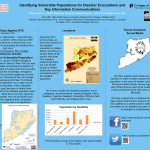 Elisa Csorba, Identifying Vulnerable Populations for Disaster Evacuations and Key Information Communications
Elisa Csorba, Identifying Vulnerable Populations for Disaster Evacuations and Key Information Communications
One of the major causes of failed emergency response to Superstorm Sandy in New York City was the lack of knowledge concerning the locations of the disabled population throughout the five boroughs of the city. Without this knowledge, emergency responders could not provide assistance to those who needed it most. Because of this, the College community has partnered with New York Rising Community in the statewide Go to High Ground initiative for the evacuation of the vulnerable population. Our goal has been to locate those citizens who are part of the disabled population here on Staten Island. While there are many agencies who serve the disabled, they are prevented from sharing information regarding their consumers’ locations due to privacy laws and regulations.
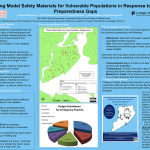 Ariana Zuberovic, Developing Model Safety Materials for Vulnerable Populations in Response to Disaster Preparedness Gap
Ariana Zuberovic, Developing Model Safety Materials for Vulnerable Populations in Response to Disaster Preparedness Gap
Superstorm Sandy devastated the Staten Island area, leaving homes destroyed and evacuation centers filled to capacity. With the chaos that ensued, the city’s vulnerable population was left helpless. Post Sandy, New York City was sued in a class action lawsuit. The Vulnerable Evacuation Court Case Against New York City encompasses the frustration various organizations of New York felt about the mistreatment of persons with disabilities. Did the city of New York do its best in evacuation and the aftermath of Superstorm Sandy? Was The City of New York found responsible for failing to address the needs of the vulnerable population? The horror stories of the witnesses served as the motivation for improved preparedness materials tailored for this population. The vulnerable population depends on timely preparedness in order to ensure safe evacuation. Meetings with field experts and evacuation volunteers have been essential in deciding on what items should be provided to people with disabilities. This study seeks to explore and develop a model rescue pack for the vulnerable population based on interviews and literature review; the authors seek to establish what affordable content could be contained in a small waterproof wallet, the intent is to provide enhanced safety and comfort for individuals with special needs. The model packs will be field tested by distribution to a sample disabled population for their evaluation and review.
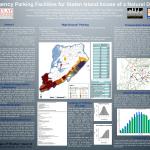 Jennifer Freund, Emergency Parking Facilities for Staten Island Incase of a Natural Disaster
Jennifer Freund, Emergency Parking Facilities for Staten Island Incase of a Natural Disaster
Superstorm Sandy left Staten Island in shambles after it slammed into its shores on October 29th, 2012. Many Staten Island residents experienced significant damages to homes, loss of personal property such as vehicles, and the death of twenty-two civilians, the highest death count of any county in The United States during this event. Over recent decades Staten Island has experienced population growth away from existing transit lines, and no large scale modifications in modes of public transportation have occurred; therefore many residents rely on private vehicles for transportation. My research is focused on devising a four step plan to evacuate residents’ vehicles to “high ground”.
